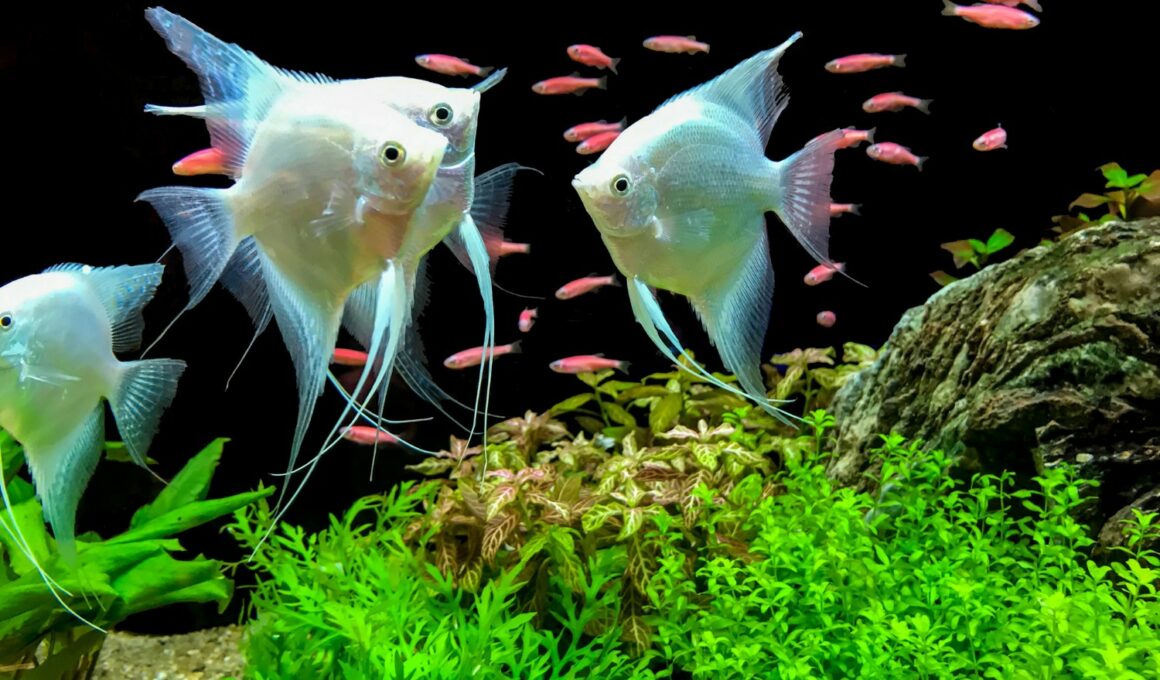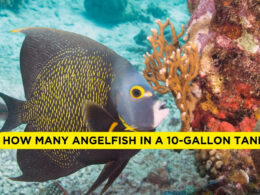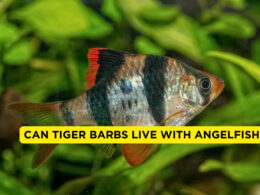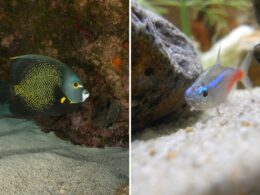In this article Show
The ethereal beauty of angelfish! With their graceful long fins and unique appearance, they’ve made quite the splash in the world of home aquariums. I’ve spent countless hours, quite literally, watching these majestic creatures glide seamlessly in my tanks, observing their quirks, behaviors, and yes, even their friendships.
When you venture into the realm of fishkeeping, one of the first things you realize is that not all fish can coexist harmoniously. It’s not just about dumping a bunch of fish into a tank and hoping they get along.
This is especially true for angelfish, which come with their own set of preferences when it comes to tank buddies. The ideal tank mate is a bit like finding the perfect roommate; compatibility matters.
If you’re on a quest to find the best tank mates for your angelfish—ones that will foster a peaceful and balanced aquatic environment—you’re in the right place. Dive in as we navigate the waters of the perfect angelfish companionship.
Understanding Angelfish Behavior and Needs
To create a harmonious environment for any species, it’s essential to understand their inherent nature, behaviors, and requirements. The same holds for angelfish. Let’s dive deeper into these elegant beings and grasp what makes them tick.
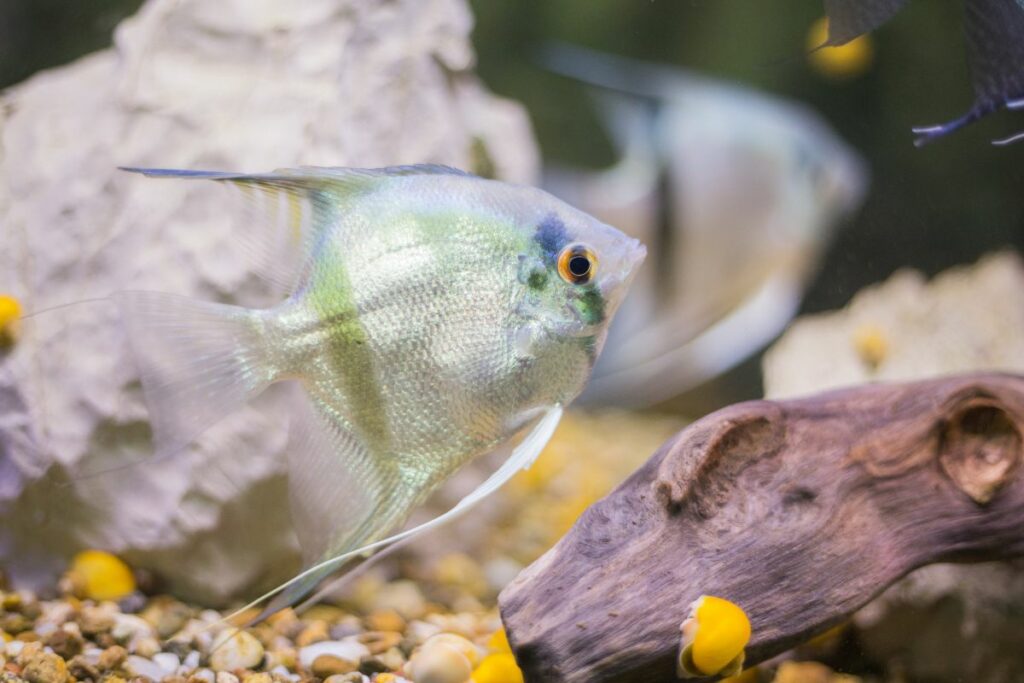
1. Angelfish Temperament
At first glance, with their elegant long fins and slow movement, angelfish might come across as the peaceful monks of the aquatic world. However, don’t be entirely fooled by their serene facade.
While they’re not the bullies of the aquarium, angelfish have a semi-aggressive side, especially when they feel their territory is threatened. This isn’t out of malice, but rather, a natural instinct.
In the wild, defending their domain ensures their survival and this trait has carried over into domestic tanks. It’s a key reason why the selection of tank mates for angelfish requires careful consideration.
2. Space and Territory Considerations
Angelfish, owing to their broad, vertical body shape and long fins, need ample space to swim and glide freely. Cramping them can lead to heightened stress and an increase in territorial disputes.
Ideally, a single angelfish should have at least 10 gallons of water to itself, and if you’re considering a pair or a group, you’ll need a substantially larger tank. Providing them with ample space not only ensures they’re comfortable but also reduces the chances of territorial aggression towards other fish.
Moreover, including plants, rocks, and hiding spots are beneficial. These act as natural barriers and give angelfish, and their tank mates, spots to claim and retreat to if needed.
3. Ideal Water Conditions and Parameters
Angelfish thrive in specific water conditions. Here’s a breakdown:
- Temperature: The ideal range is between 76°F to 82°F (24°C to 28°C). Consistency is crucial, so avoid sudden temperature fluctuations.
- pH Level: Angelfish prefers slightly acidic to neutral water. Aim for a pH between 6.5 to 7.5.
- Water Hardness: Soft to moderately hard water is ideal, falling in the range of 3 to 8 dKH.
- Cleanliness: Like all fish, angelfish need clean water. Regular water changes, coupled with a good filtration system, are essential to remove waste and prevent the buildup of harmful toxins.
Benefits of Proper Tank Mates for Angelfish
When setting up an aquarium, especially one with a focal species like the angelfish, the goal isn’t just aesthetics or a headcount of fish species.
The main aim is to create a healthy, thriving ecosystem that mimics, as closely as possible, the natural habitats of the aquatic inhabitants. Choosing the right tank mates for your angelfish plays a pivotal role in achieving this. Let’s explore the benefits:
1. Enhancing the Natural Environment
In their native habitats, angelfish aren’t swimming around in isolation. They’re part of a diverse ecosystem, teeming with various fish species, plants, and invertebrates. Introducing compatible tank mates can emulate this natural setting, offering visual stimulation and promoting natural behaviors in angelfish.
It’s quite the experience to watch them interact, show curiosity, and even form bonds with other fish. This mimicry of their wild environment contributes significantly to their overall well-being.
2. Reduction in Stress and Territorial Disputes
Stress in fish can lead to a weakened immune system, making them susceptible to diseases. By choosing tank mates that gel well with the semi-aggressive nature of angelfish, stress levels can be kept in check.
Proper tank mates won’t encroach on the territories of angelfish aggressively and will be less likely to nip at their fins. When fish respect each other’s boundaries, there’s a significant decrease in confrontations and territorial disputes. Remember, peace in the tank equates to healthier, happier fish.
3. Creating a Balanced and Harmonious Aquarium
Diversity, when done right, leads to balance. Introducing a mix of compatible species can lead to a more balanced distribution of resources, including food, space, and hiding spots.
Different species occupy different niches within the tank. Some might be bottom dwellers, while others prefer the middle or top sections.
This ensures that no single area is overcrowded, allowing for a more efficient and natural utilization of resources. The result? A harmonious aquarium where every inhabitant has its place, and the ecosystem thrives as a whole.
Best Angelfish Tank Mates
Selecting the right companions for your angelfish is essential, not just for aesthetics but also to ensure a balanced and harmonious aquarium environment. Among the most compatible species for angelfish are certain types of tetras.
Tetras
Here’s a detailed look into some of these tetras:
1. Rummy-nose Tetra
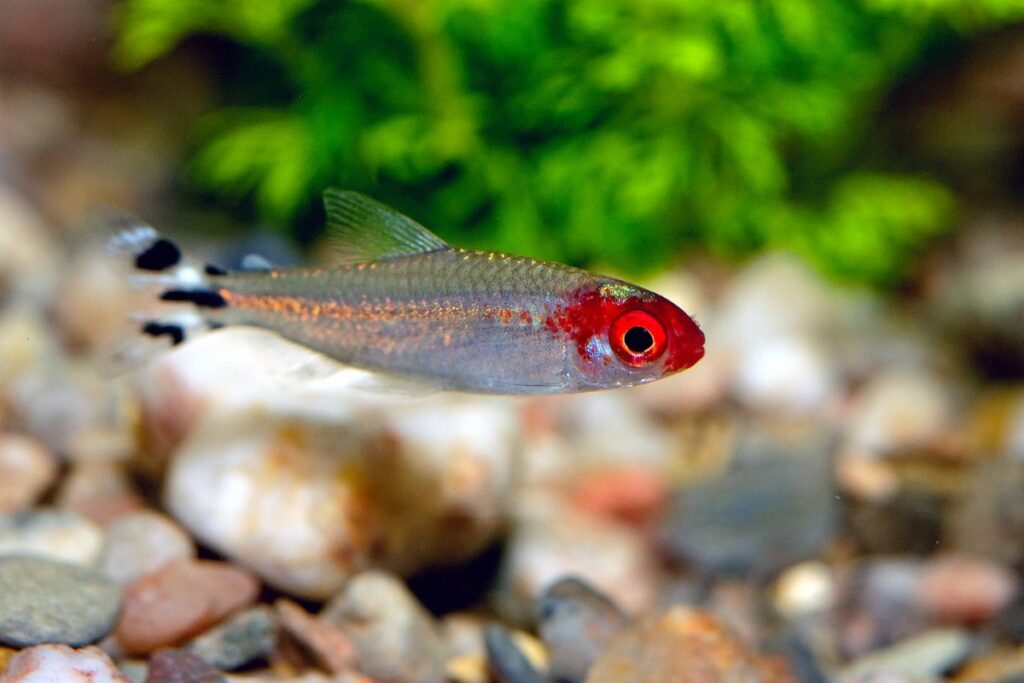
| Attributes | Details |
| Size | 2 to 2.5 inches (5-6.5 cm) |
| Diet | Omnivore |
| Temperament | Peaceful |
| Care Level | Intermediate |
| Minimum Tank Size | 20 gallons (75 liters) |
Rummy-nose Tetras are instantly recognizable by their distinct red noses, a feature from which they derive their common name. This coloration extends from the tip of their nose to their eyes, creating a striking contrast against their silver bodies. Another notable characteristic is the unique black-and-white pattern on their tail
In terms of behavior, Rummy-nose Tetras are schooling fish, meaning they thrive best in groups, preferably of six or more. Their peaceful nature makes them an excellent choice for community tanks.
These tetras are known to be sensitive to changes in water parameters, and their nose coloration can be an indicator of water quality; a faded red might mean it’s time to check the water conditions.
2. Cardinal Tetra
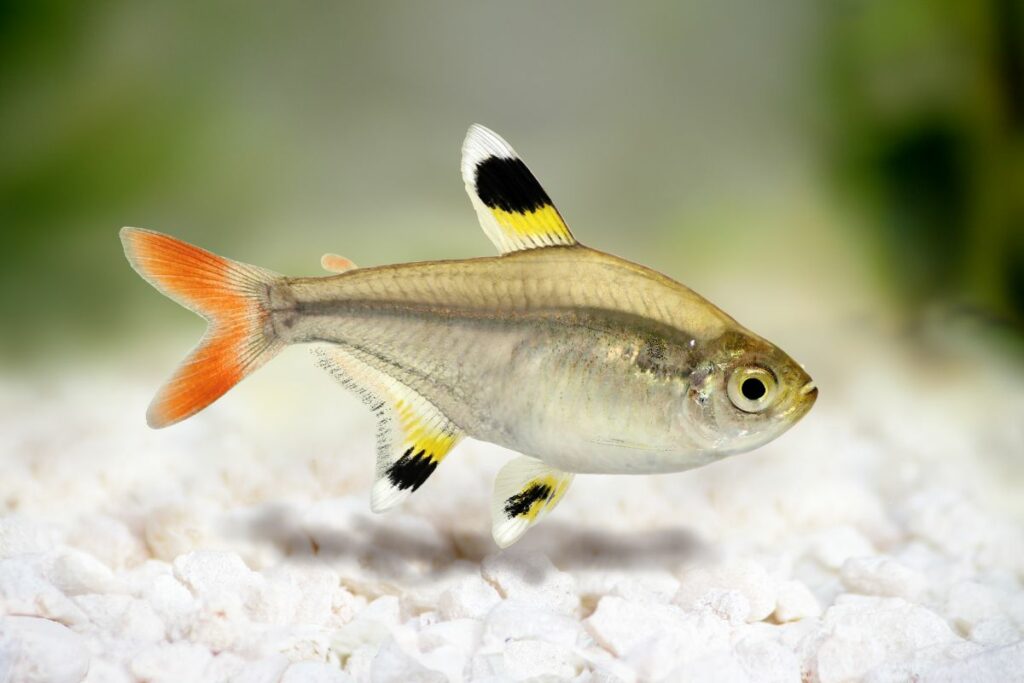
| Attributes | Details |
| Size | 1.5 to 2 inches (3.8-5 cm) |
| Diet | Omnivore |
| Temperament | Peaceful |
| Care Level | Intermediate |
| Minimum Tank Size | 20 gallons (75 liters) |
Cardinal Tetras are, without a doubt, one of the most popular freshwater fish, and it’s easy to see why. Their brilliant neon blue and red stripes running the length of their bodies make them a dazzling sight, especially when they school together.
They are often confused with Neon Tetras, but Cardinals have more extended red stripes. Peaceful and relatively easy to care for, Cardinal Tetras do well in community tanks with soft, slightly acidic water.
Being native to the slow-moving waters of South America, they prefer densely planted tanks, which offer plenty of hiding spots. When kept in the right conditions, their colors can be truly vibrant.
3. Black Neon Tetra

| Attributes | Details |
| Size | 1.5 inches (3.8 cm) |
| Diet | Omnivore |
| Temperament | Peaceful |
| Care Level | Easy |
| Minimum Tank Size | 20 gallons (75 liters) |
Black Neon Tetras, despite their name, don’t have the neon glow of their Cardinal or regular Neon counterparts. Instead, they possess an elegant black stripe edged with a white, almost silvery hue that runs through the middle of their bodies.
The contrast gives them a subtle beauty, especially when they swim in schools, reflecting light off their bodies.
They are adaptable, hardy, and perfect for beginners. Like the other tetras, Black Neons are schooling fish and should be kept in groups. Their calm demeanor ensures they coexist harmoniously with angelfish, and they add a touch of understated elegance to the tank.
Corydoras
Corydoras’ unique appearance, combined with their playful and peaceful nature, makes them perfect tank mates for a wide range of fish, including angelfish. Let’s delve into the specifics of a couple of popular Corydoras species:
4. Bronze Corydoras
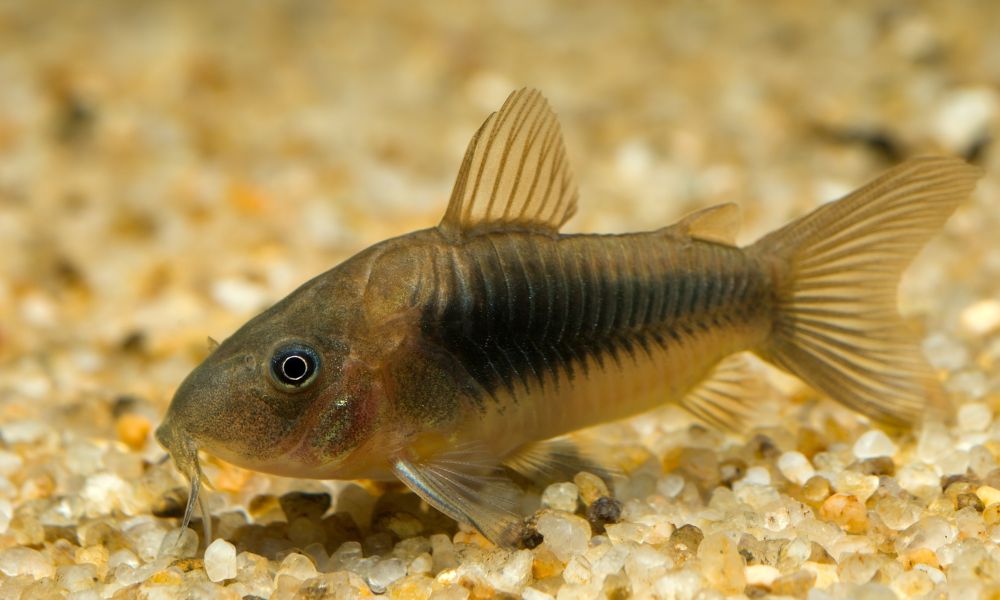
| Attributes | Details |
| Size | 2.5 to 3 inches (6.3-7.6 cm) |
| Diet | Omnivore |
| Temperament | Peaceful |
| Care Level | Easy |
| Minimum Tank Size | 20 gallons (75 liters) |
The Bronze Corydoras, also known as the Green Corydoras due to some color variations, is one of the most common and widely available Corydoras in the hobby.
Characterized by their shimmering bronze or greenish bodies, they have a robust and slightly elongated shape, with white undersides and barbels that they use to sift through the substrate in search of food.
Their peaceful demeanor and social nature make them great for community tanks. It’s recommended to keep them in groups of at least five, as they are schooling fish and thrive in the company of their own kind.
They often engage in playful antics, darting up to the surface for air (a unique trait since they possess a modified intestinal system that allows them to breathe atmospheric air) and then drifting back to the bottom.
Their diet mainly consists of sinking pellets, but they’ll also appreciate the occasional treat of live or frozen foods like bloodworms or brine shrimp. Given their scavenging nature, they also serve as natural “cleaners,” picking up leftover food and detritus from the tank floor.
5. Panda Corydoras
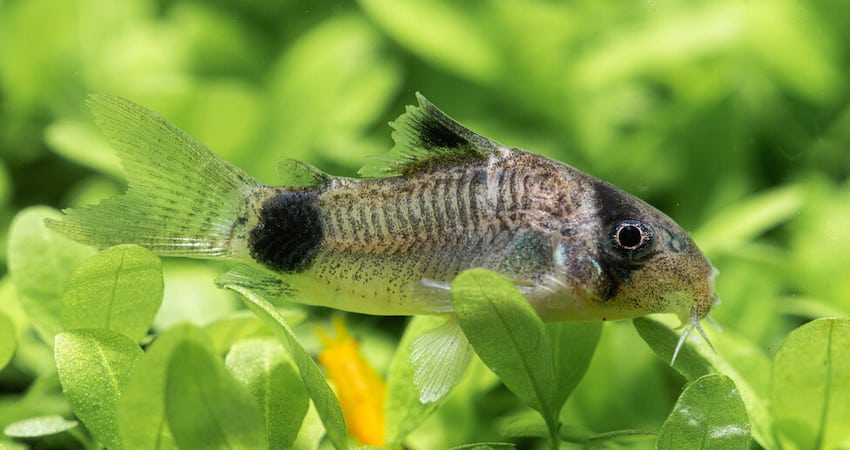
| Attributes | Details |
| Size | 1.5 to 2 inches (3.8-5 cm) |
| Diet | Omnivore |
| Temperament | Peaceful |
| Care Level | Intermediate |
| Minimum Tank Size | 20 gallons (75 liters) |
The Panda Corydoras, named for its distinct black and white coloration reminiscent of a panda bear, is an absolute favorite among aquarists. With large black patches over their eyes and at the base of their tail, combined with their white or creamy bodies, they present an adorable appearance that’s hard to resist.
Hailing from the cool waters of mountain streams in Peru, Panda Corys appreciate cooler temperatures compared to other tropical fish, ideally between 68°F to 77°F (20°C to 25°C). Like their Bronze counterparts, they are social creatures and should be kept in groups.
While they’re generally easy to care for, they are sensitive to water parameters and might require a bit more attention in this regard. Clean, well-oxygenated water is crucial for their well-being. In terms of diet, they’re not picky eaters. Sinking pellets, supplemented with live or frozen foods, will keep them in top condition.
Loaches
Loaches, with their elongated bodies and curious behaviors, are truly fascinating additions to any aquarium setup. Their nocturnal habits, paired with their distinctive appearance and playful antics, make them an enthralling choice for angelfish tanks. Here, we’ll delve into two popular species:
6. Kuhli Loach
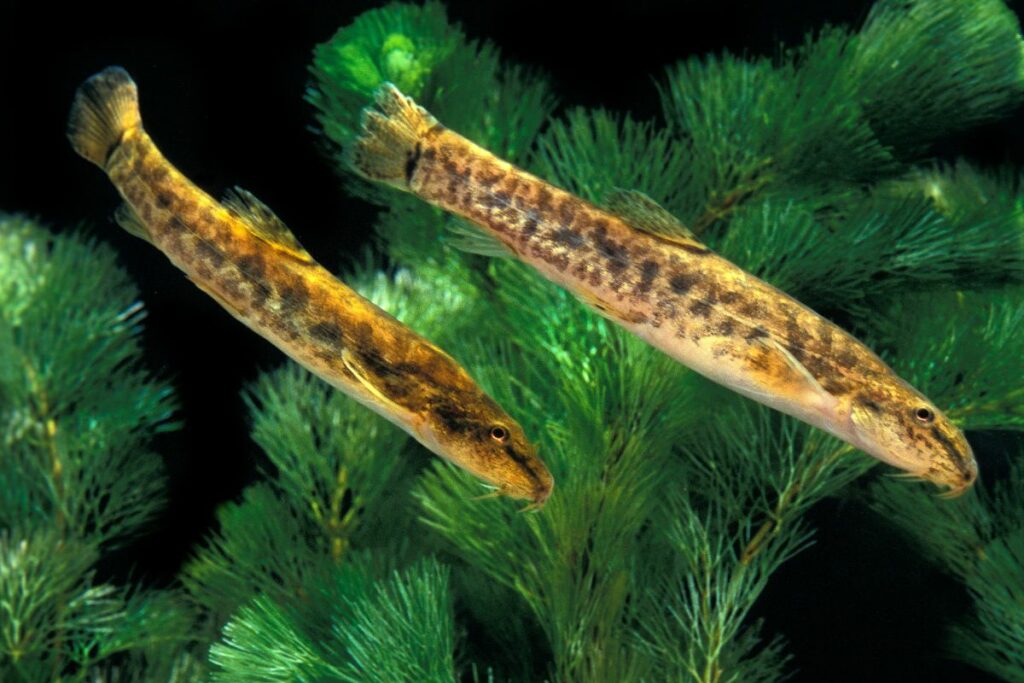
| Attributes | Details |
| Size | 3 to 4 inches (7.5-10 cm) |
| Diet | Omnivore |
| Temperament | Peaceful |
| Care Level | Easy |
| Minimum Tank Size | 20 gallons (75 liters) |
Sometimes referred to as the “eel loach” due to its elongated and slender body, the Kuhli Loach boasts a series of alternating dark and light stripes, giving it a unique and captivating appearance.
These creatures are notoriously shy, often burrowing in the substrate or hiding among the crevices during daylight hours. But when the lights go off, they come alive, scouring the tank floor for food.
Kuhli Loaches are social beings, and it’s best to keep them in groups of at least five to allow them to exhibit their natural behaviors and reduce stress. Due to their peaceful nature, they’re an excellent match for angelfish, avoiding any conflicts and staying mainly at the bottom levels of the tank.
In terms of diet, these loaches aren’t picky. While they’ll happily devour sinking pellets or wafers, they also appreciate live or frozen foods like tubifex worms, brine shrimp, or bloodworms.
When setting up a tank for Kuhli Loaches, it’s essential to provide plenty of hiding spots using plants, rocks, or driftwood and ensure that the substrate is soft to facilitate their burrowing habits.
7. Yoyo Loach
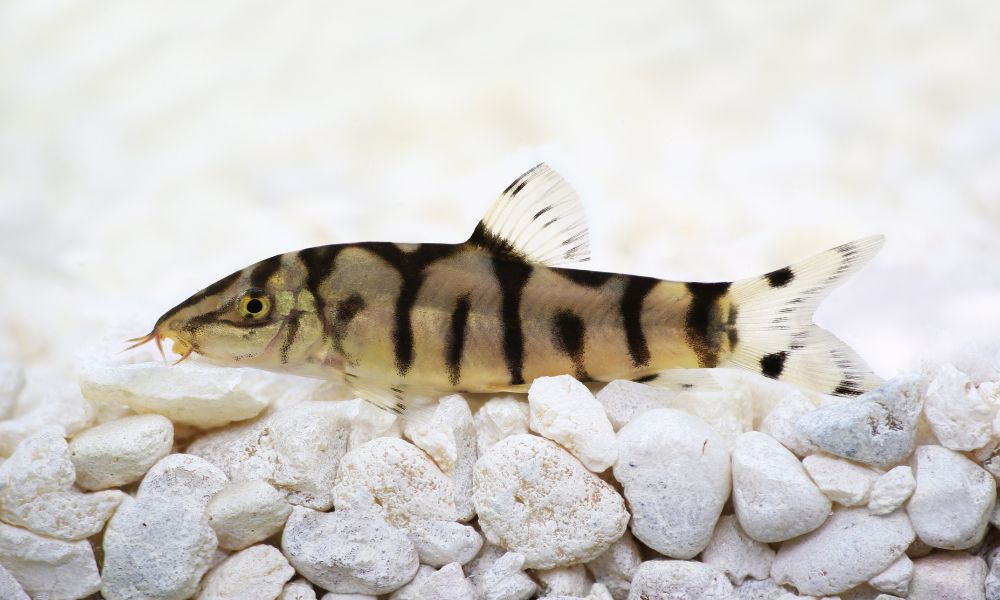
| Attributes | Details |
| Size | 2.5 to 6 inches (6.3-15 cm) |
| Diet | Omnivore |
| Temperament | Semi-aggressive |
| Care Level | Intermediate |
| Minimum Tank Size | 40 gallons (150 liters) |
The Yoyo Loach, with its distinctive and unique pattern, gets its name from the “yoyo-like” markings on its body. As they mature, the patterns may become more intricate, adding to their allure.
In terms of temperament, Yoyo Loaches are more active and assertive than the Kuhli Loaches. They’re known for their playful, sometimes boisterous behavior, often chasing each other around in the tank.
While they generally coexist well with angelfish, it’s crucial to monitor interactions, especially if the tank space is limited. As with most loaches, Yoyos love being in groups and display more natural behaviors when they have companions of their kind.
Diet-wise, Yoyo Loaches are opportunistic feeders. They’ll happily eat sinking pellets, flake foods, and live or frozen offerings such as daphnia, brine shrimp, or bloodworms. An interesting trait of Yoyo Loaches is their penchant for snails, making them a natural solution if you have a snail overpopulation in your tank.
Rasboras
Rasboras are a group of small, colorful, and active freshwater fish known for their schooling behavior and suitability for community tanks. Their peaceful nature and compact size make them ideal companions for many fish species, including angelfish. Let’s dive into the details of some popular Rasbora species:
8. Harlequin Rasbora

| Attributes | Details |
| Size | 1.5 to 2 inches (3.8-5 cm) |
| Diet | Omnivore |
| Temperament | Peaceful |
| Care Level | Easy |
| Minimum Tank Size | Size 10 gallons (38 liters) |
Harlequin Rasboras are renowned for their iconic deep orange hue, complemented by a distinct black triangular patch towards the rear. Native to the soft, acidic waters of Southeast Asia, they add a splash of color to any aquarium.
Being schooling fish, they’re best kept in groups of at least six, allowing them to display their natural swarming behavior, which is both active and coordinated.
Their diet typically consists of small invertebrates in the wild, but in a home aquarium, they’ll readily accept flake food, micro pellets, and occasional live or frozen foods like daphnia or brine shrimp.
9. Espei Rasbora
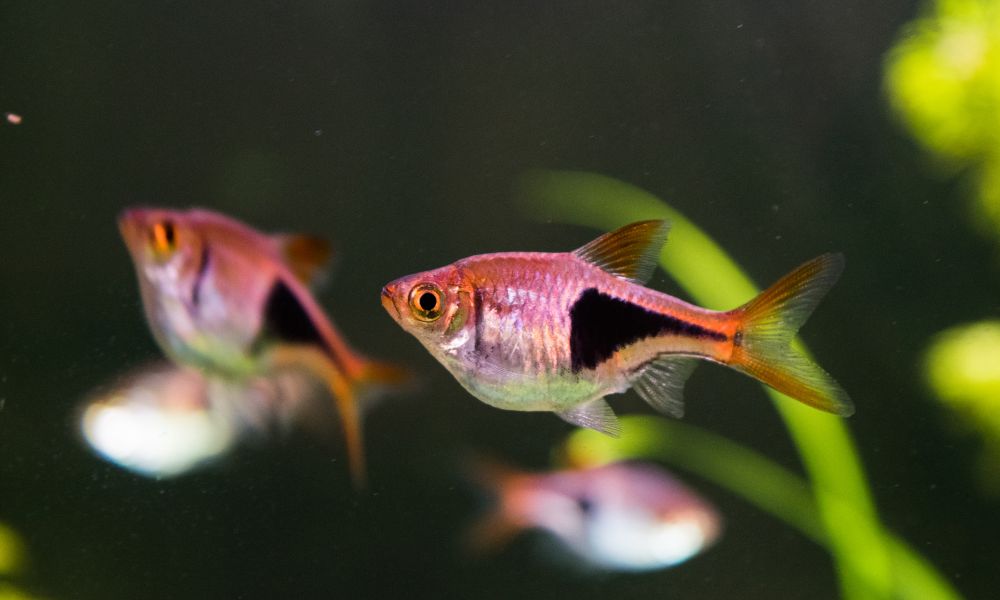
| Attributes | Details |
| Size | 1.2 to 1.4 inches (3-3.5 cm) |
| Diet | Omnivore |
| Temperament | Peaceful |
| Care Level | Easy |
| Minimum Tank Size | Size 10 gallons (38 liters) |
Often mistaken for Harlequin Rasboras due to their similar appearance, Espei Rasboras are slightly smaller with a more slender body. They possess a lovely orange-pink hue, accentuated by a thinner black marking on their side.
Originating from Thailand’s peat swamps, these fish prefer soft, slightly acidic water conditions. They’re lively and active swimmers, often darting around the tank, especially when in the company of their own kind.
Just like Harlequins, Espei Rasboras thrive in groups and add a dynamic element to the aquarium. Their diet is relatively simple, consisting of flake foods, small pellets, and occasional treats of live or frozen micro foods.
10. Galaxy Rasbora
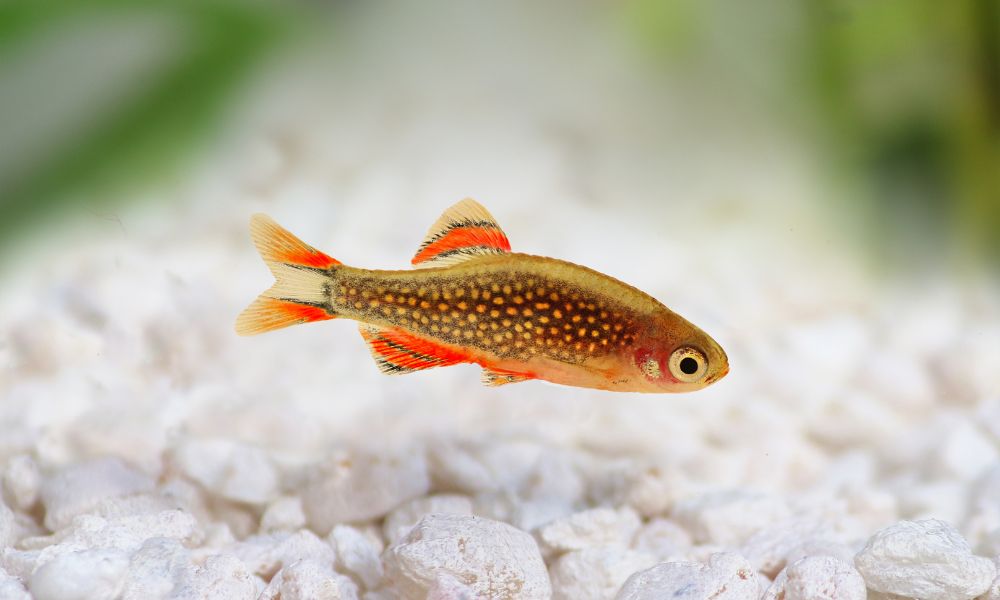
| Attributes | Details |
| Size | 0.8 to 1 inch (2-2.5 cm) |
| Diet | Omnivore |
| Temperament | Peaceful |
| Care Level | Intermediate |
| Minimum Tank Size | Size 10 gallons (38 liters) |
Also known as Celestial Pearl Danio, the Galaxy Rasbora is a captivating little fish with a starry pattern on its deep blue body, evoking images of a night sky, hence its name. Their fins are adorned with a contrasting red or orange hue, making them one of the most visually striking rasboras.
Native to the small ponds of Myanmar, they enjoy densely planted tanks that offer them plenty of hiding spots and mimic their natural environment. While they’re peaceful by nature, their small size makes them vulnerable to larger, more aggressive fish.
However, angelfish, given their generally calm demeanor, can coexist with Galaxy Rasboras provided the tank is spacious and offers plenty of vegetation.
In terms of diet, they’re not particularly fussy eaters. A combination of high-quality flake food, micro pellets, and live or frozen foods like daphnia or microworms will keep them healthy and vibrant.
Dwarf Cichlids
Dwarf Cichlids, smaller relatives of the larger Cichlid family, are often chosen by aquarists looking for character-packed fish without the demand of a massive tank.
Their vivid colors and intricate behaviors provide endless entertainment and intrigue. Among the popular choices in this category are the Blue and Bolivian Rams. Let’s delve deeper into their individual profiles:
11. Blue Ram
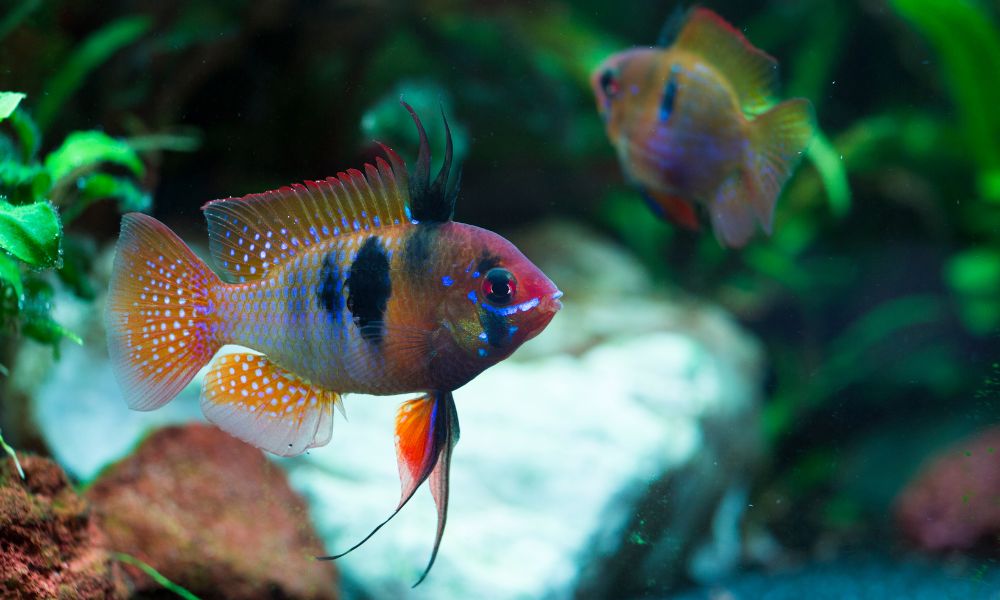
| Attributes | Details |
| Size | 2 to 3 inches (5-7.5 cm) |
| Diet | Omnivore |
| Temperament | Peaceful |
| Care Level | Intermediate |
| Minimum Tank Size | 20 gallons (75 liters) |
The Blue Ram, sometimes known as the German Blue Ram, is a vibrant dwarf cichlid prized for its brilliant color palette. With a golden body juxtaposed against electric blue speckles and patches, the Blue Ram is undoubtedly a showstopper. Its striking black vertical stripe right across its eyes adds further to its allure.
Originating from the Orinoco River basin in Venezuela and Colombia, these fish prefer warm, soft, and slightly acidic water. In terms of behavior, Blue Rams are generally peaceful and often form monogamous pairs, displaying fascinating courtship and breeding rituals.
They are bottom dwellers and enjoy sifting through soft substrates. Diet-wise, while they accept high-quality flake and pellet foods, they particularly relish live or frozen foods like bloodworms, brine shrimp, and daphnia, which also help intensify their colors.
It’s worth noting that while Blue Rams are peaceful, they can be territorial during breeding. However, their calm demeanor generally makes them compatible with angelfish.
12. Bolivian Ram
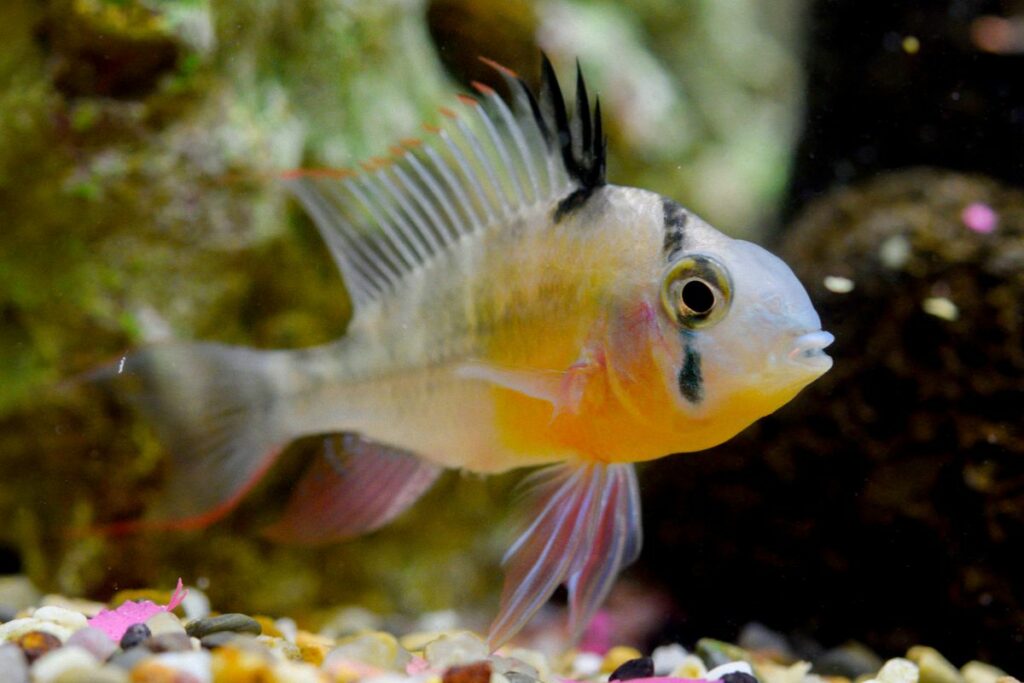
| Attributes | Details |
| Size | 2.5 to 3.5 inches (6.3-8.9 cm) |
| Diet | Omnivore |
| Temperament | Peaceful |
| Care Level | Easy to Intermediate |
| Minimum Tank Size | 20 gallons (75 liters) |
Bolivian Rams, as the name suggests, hail from Bolivia and parts of Brazil. They might not be as flamboyantly colored as their Blue counterparts, but their subtle earthy hues, combined with hints of blue, gold, and red, make them equally enchanting. A distinct feature is their long, pointed dorsal fin, adorned with a black dot.
Bolivian Rams are hardier than Blue Rams, making them an excellent choice for those new to dwarf cichlids. They enjoy a similar environment: warm, soft water with plenty of plants and hiding spots. Sand or soft substrate is preferable, allowing them to display their natural digging behavior.
In terms of temperament, they’re generally peaceful and can coexist harmoniously with other calm community fish, including angelfish. They are, however, more solitary than the Blue Rams, and while they might pair up, they don’t form as strong bonds as the Blue Rams.
Their diet is varied, and they will happily accept flake foods, pellets, and live or frozen offerings. Regular feeds with high-quality foods will help enhance their beautiful colors.
Invertebrates
Invertebrates play an essential role in creating a balanced ecosystem. Their unique behaviors, ecological benefits, and captivating forms make them a top choice for many aquarists. Especially when paired with angelfish, invertebrates can add layers of interest to your tank. Here’s a closer look at some popular invertebrate choices:
13. Mystery Snails
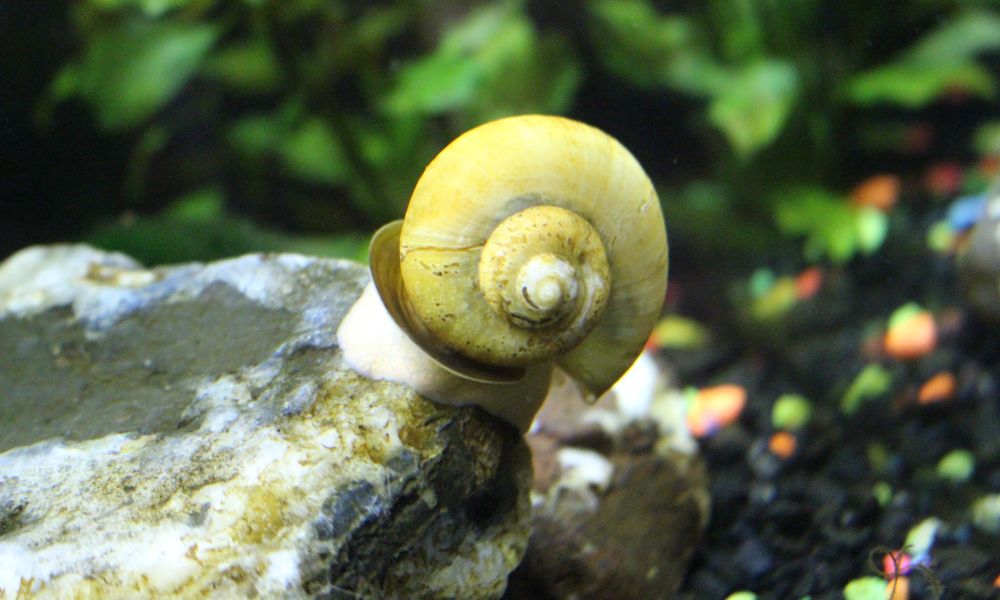
| Attributes | Details |
| Size | Up to 2 inches (5 cm) |
| Diet | Omnivore |
| Temperament | Peaceful |
| Care Level | Easy |
| Minimum Tank Size | 10 gallons (38 liters) |
Mystery Snails are among the most popular freshwater snails, known for their vibrant colors, including gold, blue, black, and purple. Their rounded shells and active behaviors make them both aesthetically pleasing and functionally beneficial.
They play a pivotal role in cleaning the tank by consuming algae, decaying plant matter, and uneaten fish food, ensuring a clean substrate. With their operculum (a bony plate), they can seal themselves in their shells if they feel threatened or when the water conditions are not optimal.
Despite their slow movements, watching a Mystery Snail navigate the aquarium, extend its siphon to get air, or lay its eggs can be surprisingly captivating. They’re non-aggressive and coexist peacefully with angelfish. Their diet can be supplemented with algae wafers or blanched vegetables like lettuce or zucchini.
14. Ghost Shrimp
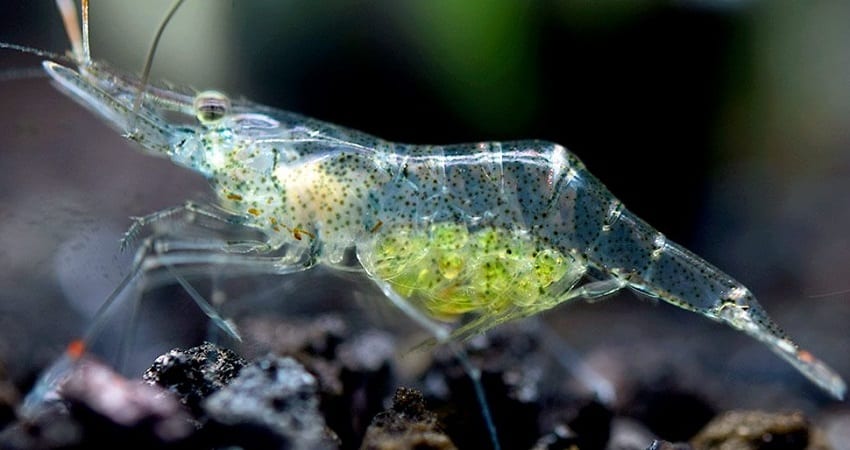
| Attributes | Details |
| Size | Up to 1.5 inches (3.8 cm) |
| Diet | Omnivore |
| Temperament | Peaceful |
| Care Level | Easy |
| Minimum Tank Size | 5 gallons (19 liters) |
Ghost Shrimp, also known as Glass Shrimp, are fascinating due to their almost transparent bodies, which offer a unique view into their internal workings. They are highly active, always scavenging and picking through the substrate for food particles.
These shrimps serve as a natural cleaning crew, consuming algae, detritus, and any leftover food, thereby helping to maintain water quality. Due to their small size and peaceful nature, they can coexist harmoniously with angelfish, provided the fish aren’t overly aggressive or large enough to view the shrimp as food.
While Ghost Shrimp will feed on naturally occurring algae and detritus, they’ll appreciate occasional supplemental feeding with shrimp pellets or blanched vegetables.
15. Nerite Snails
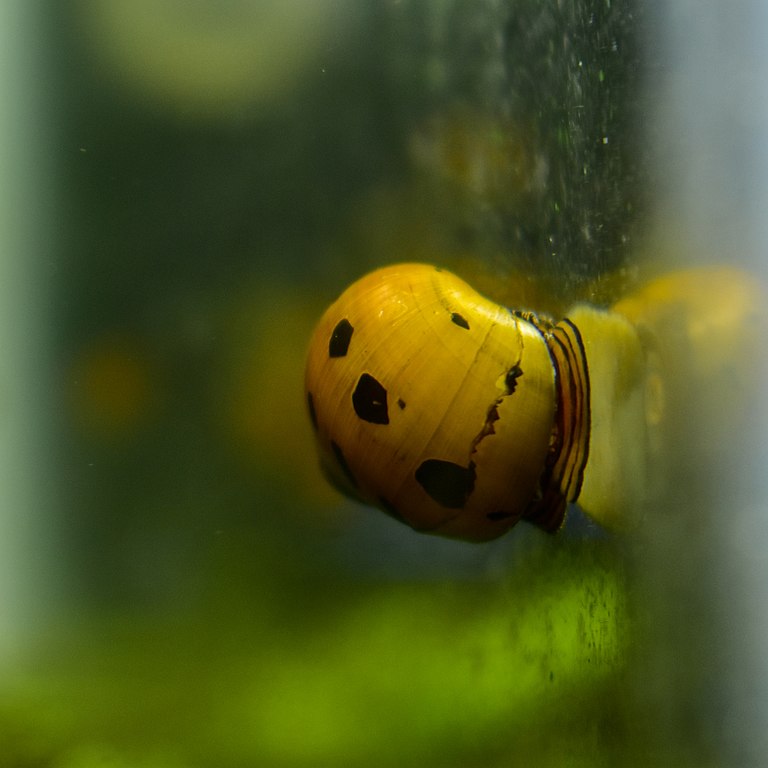
| Attributes | Details |
| Size | Up to 1 inch (2.5 cm) |
| Diet | Herbivore |
| Temperament | Peaceful |
| Care Level | Easy |
| Minimum Tank Size | 5 gallons (19 liters) |
Nerite Snails are small but mighty algae eaters, making them invaluable assets for any freshwater aquarium. They come in a variety of patterns and colors, from zebra stripes to solid colors with intricate designs.
One of the primary reasons aquarists love Nerite Snails is their unmatched ability to combat algae, especially on glass surfaces and decorations. They are tireless cleaners, moving methodically through the tank. Unlike other snails, Nerites won’t reproduce in freshwater, so there’s no risk of unwanted population explosions.
They are completely peaceful and will coexist without issues with angelfish. Their primary diet consists of algae, but during times of scarcity, they can be supplemented with algae wafers.
Tank Mates to Avoid When Keeping Angelfish
Angelfish, with their graceful long fins and serene beauty, are a favorite among aquarists. But, just like every other fish, they have their own set of requirements and quirks.
While they can coexist harmoniously with many species, there are certain fish that can pose problems when housed with angelfish. Here’s a breakdown of the types of tank mates to avoid:
1. Fish that Nip Fins
Angelfish are known for their long, flowing fins. Unfortunately, these can be tempting for fin-nipping fish. Tiger Barbs, for instance, are notorious for their nippy behavior.
They tend to be drawn to the long fins of angelfish which might cause them harm. Repeated nipping not only damages the beautiful fins but can also lead to stress, and in some cases, infections in the angelfish.
2. Overly Aggressive Fish
While angelfish have a semi-aggressive nature, they are not equipped to handle very aggressive tank mates. Fish that have a territorial or combative disposition can stress out angelfish, leading to health issues or even physical harm.
Examples of these aggressive fish are some Cichlid species, such as the Red Devil or the Jewel Cichlid. It’s essential to ensure that any fish added to an angelfish tank has a temperament that’s compatible with them.
3. Fish that are Too Small
Angelfish, in their natural habitat, feed on smaller fish and invertebrates. Even though they are usually peaceful in a community setting, they might revert to their predatory instincts when presented with tiny, easy-to-catch tank mates.
Examples are tiny species like microrasboras or baby guppies. Therefore, very small fish might be at risk in a tank with fully grown angelfish.
Considerations For Introducing New Tank Mates
Introducing new tank mates to an established aquarium is both exciting and a bit nerve-wracking.
While the addition of new fish can invigorate the tank’s dynamics, it’s vital to ensure that the transition is smooth for both the new arrivals and the existing inhabitants. Here are some crucial considerations to keep in mind:
1. Proper Acclimatization Techniques
Different fish may come from environments with varying water parameters. Directly adding new fish can shock them, leading to stress or health issues.
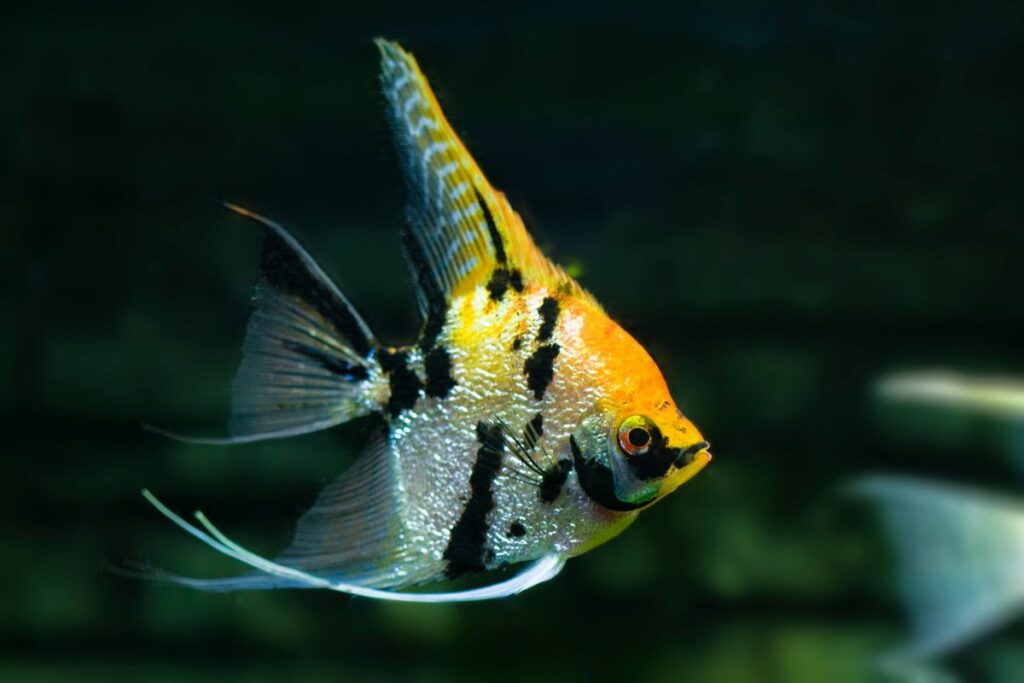
What to Do
Float the Bag
Start by floating the sealed bag containing the new fish in the aquarium for about 15-30 minutes. This equalizes the temperature between the bag water and the tank water.
Drip Acclimation
After temperature acclimation, slowly introduce tank water into the bag over an hour or more, especially if you suspect significant differences in water parameters. This can be done using a drip line or by periodically adding small amounts of tank water into the bag.
Net and Transfer
Once acclimated, use a net to transfer the fish from the bag to the tank. Avoid adding bag water to the aquarium to prevent any potential contaminants.
2. Ensuring Adequate Hiding Spots and Plants
New additions might feel stressed or threatened in a new environment. Providing ample hiding spots allows them to retreat and feel safe, reducing stress.
What to Do
Plants
Live or artificial plants can offer shelter and security. Plants like Java Fern, Anubias, or Vallisneria provide good cover.
Decorations and Caves
Rocks, driftwood, or specially designed caves and tunnels can serve as hideaways for fish.
Strategic Placement
When adding new decor or plants, consider the natural behavior of the fish. Bottom-dwellers will appreciate hides near the substrate, while mid-dwellers might utilize dense plant thickets.
3. Monitoring Behavior During the First Few Weeks
Even if fish are known to be compatible, individual temperaments can vary. Monitoring ensures early detection of potential aggression or bullying.
What to Do
Observation
Spend some time each day observing the interactions among the fish. Pay attention to any chasing, fin-nipping, or other signs of aggression.
Feeding Behavior
Ensure that all fish get their share of food. Sometimes, dominant fish might prevent others from feeding.
Isolation
If a particular fish is consistently aggressive or if another is overly stressed, consider isolating them temporarily or rearranging the tank to disrupt established territories.
Conclusion
Introducing new fish to your aquarium requires careful acclimatization, providing hiding spots for safety, and attentive observation of their interactions. By taking these steps, you can create a peaceful and balanced tank environment for all inhabitants.






